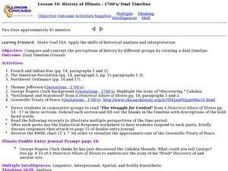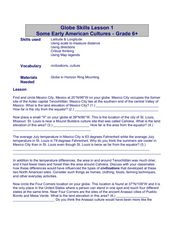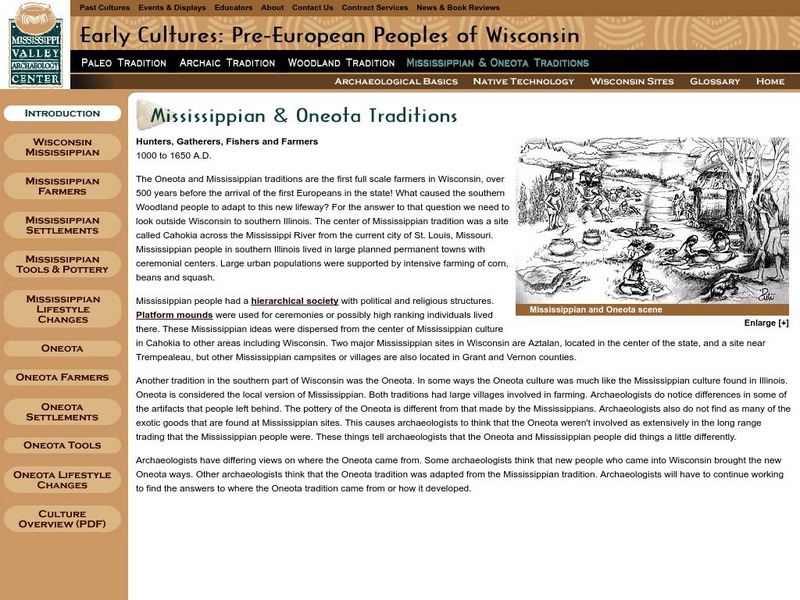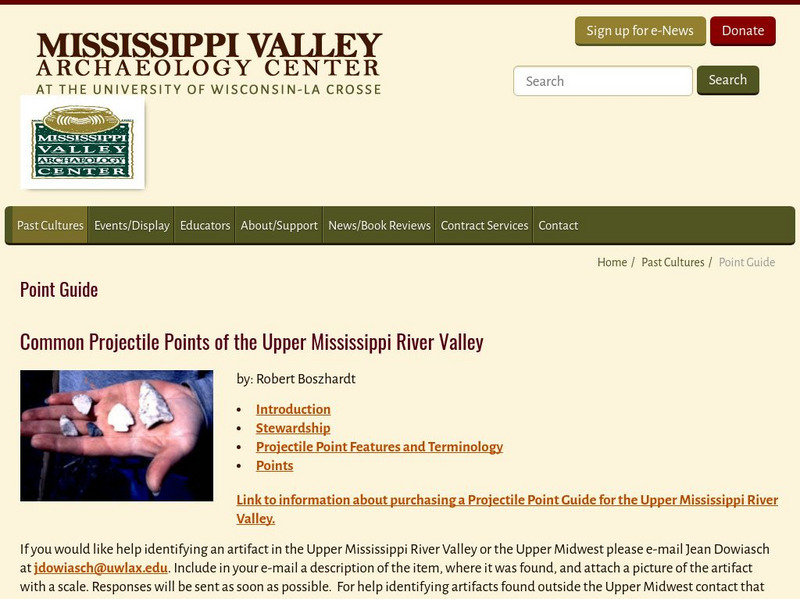Curated OER
We Really Dig Archeology and Palentology
Sixth graders examine the differences between archeology and paleontology. Using the internet, they explore the tools and techniques used in each field. They must use the correct tools to uncover and record the objects they find. They...
Curated OER
Lesson 10: History of Illinois 1700's Dual Timeline
Students create a journal that includes historic events that occurred in Illinois in the 1700's that features entries on the same topics from different perspectives.
Curated OER
Globe Skills Lesson 1 Some Early American Cultures
Students apply their knowledge of geography. In this geography skills lesson, students read brief selections regarding early Americans. Students respond to the questions included in the self-guided map skills lesson.
Other
Cahokia Mounds State Historic Site: Explore
An extensive look at the Cahokia Mounds which can be explored by mound name or number. An interactive timeline traces the development of the civilization at the place that the Cahokia mounds were eventually built. The section on the...
Other
University of Wisconsin: Cahokia Mounds Research Facility
This resource offers excellent photographs of excavations in progress although there is not much detail of Mississippian culture.
United Nations
Unesco: Cahokia Mounds State Historic Site
This World Heritage site includes a photograph of Cahokia as it appears today, a brief description of the excavation of the site, and a short video.
Other
Cabrillo College: Cahokia
A concise, bulleted description of Cahokia, the major trade and population center of the Mississippian Mound Builders on the banks of the Mississippi River.
The Washington Post
Ancient Cahokia: Metropolitan Life on the Mississippi
This article from the Washington Post gives a great description of Cahokia, one of the largest cities in the world before Columbus' contact with the New World. Read about how the great mounds were made, the trade networks established,...
University of Groningen
American History: Outlines: Mound Builders and Pueblos
The first Native-American group to build mounds in what is now the United States often are called the Adenans. They began constructing earthen burial sites and fortifications around 600 B.C. Some mounds from that era are in the shape of...
Curated OER
Unesco: United States of America: Cahokia Mounds State Historic Site
Cahokia Mounds, some 13 km north-east of St Louis, Missouri, is the largest pre-Columbian settlement north of Mexico. It was occupied primarily during the Mississippian period (800-1400), when it covered nearly 1,600 ha and included some...
University of Wisconsin
The Why Files: Effigy Mound Culture
Site introduces the concept of mound building and explains the concept in easy-to-understand terms. Discover why the mounds were build and what they possibly meant to the ancient people.
University of Groningen
American History: Outlines: Early America: Mound Builders and Pueblos
A brief survey of the mound building and cliff dwelling Native Americans in the period between 1000 BC and 1600 AD.
Curated OER
Wikipedia: National Historic Landmarks in Illinois: Cahokia Mounds
Largest archaeological site related to Mississippian culture.
Other
The American Institute of Architects: Illinois Great Places
Discover the impressive architecture scattered throughout the state of Illinois. Landmarks range from A.D. 1000 with the Cahokia Mounds to the few buildings in 2005.
Other
Early Cultures: Pre European Peoples of Wisconsin: Mississippian and Oneota
The Mississippian and Oneota cultures were the first true farmers in the Mississippi Valley. Read about their transition from hunting and gathering, and see what differences in their life styles farming brought about. Find a chart that...
Other
Mississippi Valley Archaeolgy Center: Common Projectile Points
This scholarly work describes the various projectile points used by Paleo-Indians and later cultures in the Upper Mississippi Valley. Find diagrams, photographs, and descriptions of the points, and compare their differences and...














